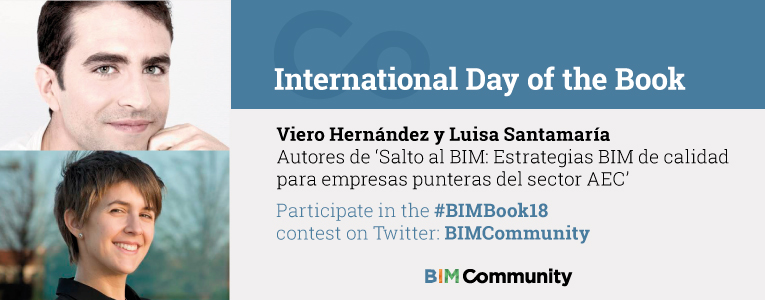"Big size entreprises believe that their survival depends on its finances and clients and risk forgetting about productivity"
We interview the authors of “Move Into BIM: Quality strategies for AEC’s sector leading-edge enterprises”, Viero Hernandez and Luisa Santamaría

We wanted to know more about these BIM experts that, in addition of participating as juries, will give one book as a gift to their prefered participant. In this first article, Viero Hernández, “Move Into BIM”’ authors, elaborates on the contents readers may find in the book she has co authored with Luisa Santamaría. We have asked him to tell us about secrets for a successful BIM implementation, will he reveal them?
Viero Hernández, “Move Into BIM: Quality strategies for AEC’s sector leading-edge enterprises”
BC. Who are Viero Hernández and Luisa Santamaría?
VH: I sometimes feel as if we were four persons instead of just two of us. BIM Manager (Luisa) and building with BIM’s aid (me) by day and, both of us, BIMfluencers by night.
We help entreprises and professionals achieve a successful BIM implementation. Our speciality? Making the latest technologies easy to understand and put to motion from scratch. Using Harry Potter as guidance, I call Luisa “BIM’s Hermione” because she’s reckless when it comes to improving her BIM knowledge. On the other side, she calls me “BIM’s Fred Weasley”, for I have a tendency to risk doing new things, such as taking my BIM Models straight to the building site: ‘Stuff might explode but I just have to prove it!”.
We also help engineers and architects to keep up-to-date with the latest BIM methodologies’ trends. That goes from BIM implementation, standards and BIM programming to teaching about specific softwares such as Revit or BIM management strategies. At especialista3d.com you will find tons of material about those topics (in Spanish only for the moment).
VH: It is aimed at anyone who has already noticed that BIM processes are much more than a change in the tools we use. We want the inexperienced reader to find in the book an open door to a world of professional opportunities, new advanced tools and best practices. Everything is written in a simple language. The experienced reader will immerse himself in business and productivity strategies and many tips that will empower him to advance towards a continuous quality improvement.
VH: I can’t say there’s a secret at all. What I do believe is that (both on a particular level and at an enterprise level) at all scales only three points are needed to achieve a successful BIM implementation: vision, grit and compromise. Vision in order to be able to spot the opportunities this new technology brings with it, and also the challenges for there are no opportunities without challenges. Grit to “move into BIM· with full determination and energy, never giving up halfway. Compromise so that we do not give into the temptation to go back in time when scared.
Tell us about the challenges of the spanish AEC sector involving BIM methodologies.
I think there is a chronic lack of self esteem between all the spanish professionals and enterprises. Big enterprises, with projects all over the world, think that their success depends only on having clients and funds, but they often dismiss investing in productivity. Then we can see the average
We realized that to make a technological change in our environment we will have to keep an eye in business processes. So we started to look abroad.
From Australia, we admire their production standards, and their regulatory environment is remarkable. Then we have the UK, with their emphasis in formation and recruitment processes. And working for the arab countries we have learned a lot about BIM team coordination.
I think the United States are, nowadays, at the cutting edge in automation fields, no matter the industry or the sector. That is why we try to keep in contact with some of the pioneers of the field.
Anyway, we firmly believe that there are loads of very capable BIM professionals here in Spain that are pleading “just let me do my job”. If we just let them, probably we wouldn’t need to import anything from abroad.
What countries do you think may be a reference for the Spanish BIM context right now?
Here in Spain we have a curious issue. We are good at quick-fixing, but we are disastrous at importing references, or even copying. Consequences? Everyday I hear people complaining about bad BIM implementations. And the same problem occurs with national regulations. It doesn’t make sense to emulate a BIM guide from Pennsylvania, even though the former is both accurate and useful.
Each country should adapt their own standards to their circumstances and professionals.
And talking about techniques, they are like fashion, they come and go. But strategies last longer if they are good. That is why Luisa and I always try to concienciate about useful strategies in typical scenarios in building project and construction with BIM technologies.
In Salto al BIM we speak about what it takes for an enterprise to get involved in investigation and development. Sadly, here in Spain there’s a general belief that “it is better not to invent too much, let others do that”. However, looking for references abroad, carefully studying them and adapting those to the Spanish AEC reality can be harder than evaluating our current situation and walking ahead with the new technologies so that they meet our actual needs. If we do this, it is us who should invent! (No one knows your needs better than yourself).
Concerning the current digital revolution: what new professions does the AEC Industry need to face this new way of working?
That is a question we often receive from our readers from Especialista3d.com . Some weeks ago we published an article about this specific topic. You can check out the entire article at the link (https://especialista3d.com/que-profesionales-seran-mas-demandados-en-un-futuro-con-perfiles-bim/)
To sum up: Micro and macro 3D BIM coordination specialist, expert in planning and cost controlling with BIM techniques, VR-BIM expert, 3D BIM construction model controller, BIM facility manager, data hunters, BIM developer, legal-BIM consultant, expert in drones & bot automatic construction processes, data manager, specialist in BIM applied to Smart Cities, Gaming and IoT.












